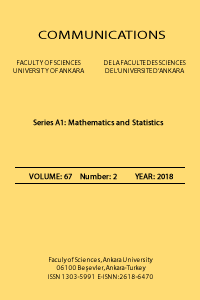NON-PROPORTIONAL HAZARDS WITH APPLICATION TO KIDNEY TRANSPLANT DATA
___
- Abrahamowicz, M., MacKenzie, T., Esdaile, J. M., Time-dependent hazard ratio: modelling and hypothesis testing with application in lupus nephritis, Journal of the American Statistical Association, 91(1996), 1432-1439.
- Ba¸sar, E., Applications of some statistical technique used in life table analysis to the kidney transplantation data, Unpublished Ph. D., thesis, Science Institute of Hacettepe University. 1993.
- Cai, Z., Sun, Y., Local linear estimation for time-dependent coe¢ cients in Cox’s regression models, Scandinavian Journal of Statistics, 30(2003), 93-111.
- Cox, D. R. Regression models and life tables, Journal of the Royal Statistical Society, Ser. B, 34(1972), 187-220.
- De Boor, C., A Practical Guide to Splines, Springer, New York, 1978.
- Eilers, P. H. C., Marx, B. D., Flexible smoothing with B-splines and penalties, Statistical Science, 89(1996), 89-121.
- Eisen, A. E., Agalliu, I., Thurston, S. W., Coull, B. A., Checkoway, H., Smoothing in occu- pational cohort studies: an illustration based on penalised splines, Occupational and Envi- ronmental Medicine, 61(2004), 854-860.
- Grambsch, P. M., Therneau T. M., Proportional hazards test and diagnostics based on weight residuals, Biometrika, 81(1994), 515-526.
- Gray, R. J., Flexible methods for analyzing survival data using splines, with applications to breast cancer prognosis, Journal of the American Statistical Association, 87(1992), 942-951. [10] Gray, R. J., Spline-based test in survival analysis, Biometrcs, 50(1994), 640-652.
- Hastie, T., Tibshirani, R., Varying-coe¢ cient models, Journal of the Royal Statistical Society, Ser. B, 55(1993), 757-796.
- Hess, K. R., Assessing time-by-covariate interactions in proportional hazards regression mod- els using cubic spline functions, Statistics in Medicine, 13(1994), 1045-1062.
- Kooperberg, C., Stone, C. J., Truong, Y. K., Hazards regression, Journal of the American Statistical Association, 90(1995), 78-94.
- Lin, D. Y., Wei, L. J., Goodness-of-…t test for the general Cox regression model, Statistica Sinica, 1(1991), 1-17.
- Moreau, T., O’Quigley, J., Mesbah, M. A., A global goodness-of-…t statistic for the propor- tional hazards model, Applied Statistics, 34(1985), 212-218.
- Quantin, C., Abrahamowicz, M., Moreau, T., Bartlett, G., MacKenzie, T., Tazi, M. A., Lalonde, L., Faivre, J., Variation over time of the eğects of prognostic factors in a population- based study of colon cancer: comparison of statistical models, American Journal of Epidemi- ology, 150(1999), 1188-1200.
- Rosenberg, P. S., Hazard function estimation using B-splines, Biometrics, 51(1995), 874-887. [18] Sleeper, A. L., Harrington, D. P., Regression splines in the Cox model with application to covariate eğects in liver disease, Journal of the American Statistical Association, 85(1990), 941-949.
- Therneau, T. M., Grambsch, P. M., Modelling Survival Data: Extending the Cox Model, Springer, New York, 2000.
- Fen-Edebiyat Fak., ·Istatistik Bölümü, 06500, Teknikokullar, Ankara, Türkiye
- E-mail address : ebasar@gazi.edu.tr
- ISSN: 1303-5991
- Yayın Aralığı: Yılda 4 Sayı
- Başlangıç: 1948
- Yayıncı: Ankara Üniversitesi
THE DISCRIMINANT OF SECOND FUNDAMENTAL FORM
A. SUNGUR ENGİN, Salih ÇELEBİOĞLU, Jong-min KIM
PARAMETER ESTIMATION IN MULTIPLE LINEAR REGRESSION MODELS USING RANKED SET SAMPLING
Yaprak Arzu ÖZDEMİR, Alptekin ESİN A.
ON /-EXTREMALLY DISCONNECTED SPACES
Aynur KESKİN, Şaziye YÜKSEL, Takashi NOIRI
